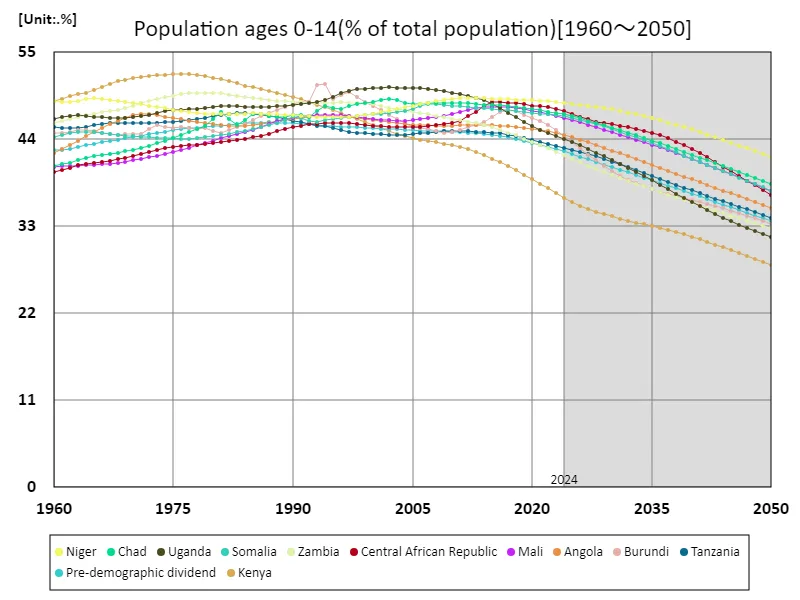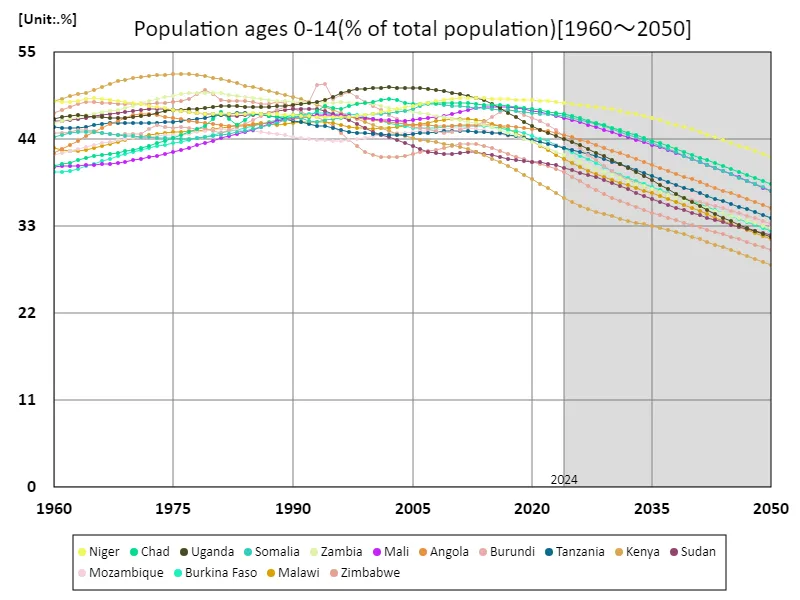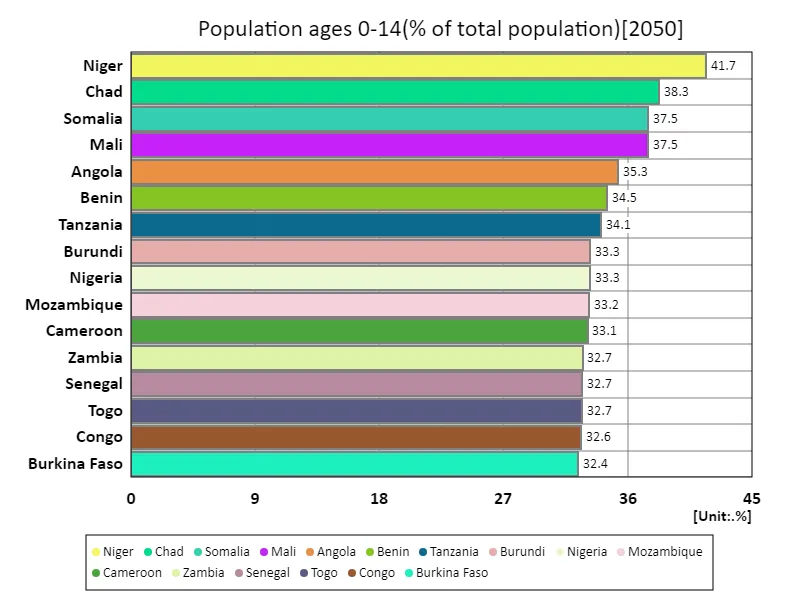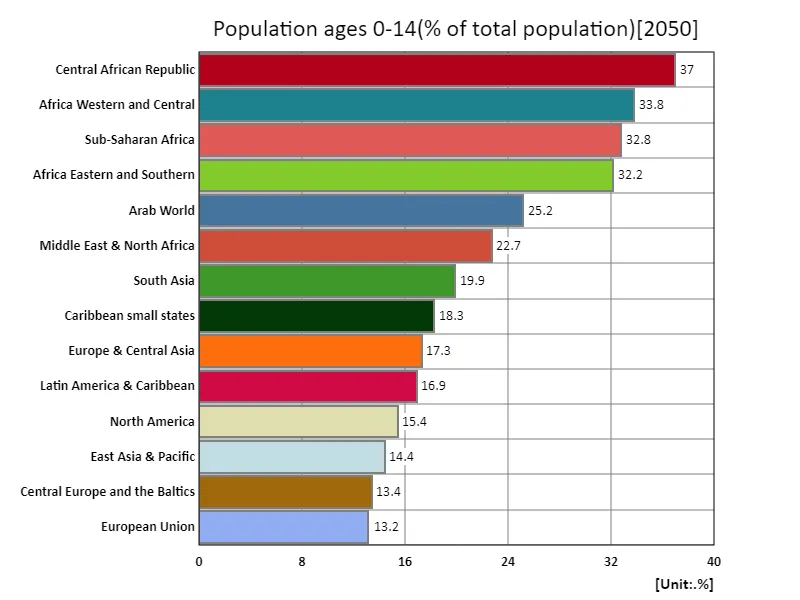- Abstract
- Population aged 0-14 (percentage of total population)
- Population aged 0-14 (percentage of total population) (worldwide)
- Population aged 0-14 years (percentage of total population) (worldwide, latest year)
- Population aged 0-14 years (percentage of total population) (region, latest year)
- Reference
Abstract
Population movement has become an important factor in recent economic trends. The increase in net migration has been particularly notable in high-income countries. The latest projections for 2050 put net migration from high-income countries at 2.54 million. This trend is consistent with immigration trends over the past few decades and is primarily driven by the following factors: First, high-income countries are pursuing policies to accept immigrants to fill labor shortages and skills gaps. There is also an increase in immigration as people seek economic opportunity, helping high-income countries attract a diverse talent pool and boosting economic growth. Furthermore, the scale of immigration depends heavily on each country’s economic stability and policy changes. High-income countries value immigrants not only as a source of labour but also as a source of cultural diversity. Overall, increased immigration to high-income countries has both economic benefits and social impacts and is likely to play an important role in the future international economy.
Population aged 0-14 (percentage of total population)
Looking at data from 1960 to 2050, Kenya’s population proportion of 0-14 year olds is notably high, peaking at 52.3% in 1976. Kenya’s high birth rate and large young population have a significant impact on the region’s economy and social structure. A high ratio of the population aged 0-14 indicates rapid population growth, increasing demand for education, medical care, and infrastructure development. Kenya’s current figure of 53.9% remains high and reflects long-term demographic changes. On the other hand, developed countries have a low ratio of people aged 0 to 14 and are experiencing rapid aging of the population, which is having a significant impact on social security and the labor market. Countries like Kenya need to develop an economic growth strategy that takes advantage of their large young population, and improving education and vocational training will be the key to success.


The maximum is 52.3%[1976] of Kenya, and the current value is about 53.9%
Population aged 0-14 (percentage of total population) (worldwide)
The proportion of Kenya’s population aged 0-14 years peaked at 52.3% in 1976 and has remained high since then, reflecting rapid population growth and a high birth rate. Data from 1960 to 2050 show that many developing countries have a high proportion of young people, which puts pressure on education, health and infrastructure development. In Kenya, the youth population remains large, as shown by the current figure of 53.9%, and this has implications for the overall social structure and economic policies. Meanwhile, in developed countries, the proportion of the population aged 0 to 14 is declining and aging is progressing. This has led to labor shortages and increased burdens on social security, raising concerns about the impact on economic growth. In countries with large youth populations such as Kenya, expanding education and employment opportunities is a key issue in supporting future economic growth.


The maximum is 52.3%[1976] of Kenya, and the current value is about 53.9%
Population aged 0-14 years (percentage of total population) (worldwide, latest year)
According to data for 2050, Niger will have the highest proportion of its population aged 0-14 at 41.7%. This indicates that the country still has a fast-growing young population. Developing countries are generally characterized by high birth rates and a high proportion of young people. A high ratio like Niger’s suggests a large demand for education, health and infrastructure development – investments in these areas are necessary for sustainable economic growth. However, the average figure of 20.4% indicates that, although young people continue to play an important role as a global trend, there are significant regional differences. Compared to developed countries, where the population is aging, developing countries will continue to have a higher proportion of young people, and this will have significant implications for economies and social policies. The overall total of 4.01k% is a combination of data from each country, but it shows a lot of variation between countries, calling for regional responses.


The maximum is 41.7% of Niger, the average is 20.3%, and the total is 3.97k%
Population aged 0-14 years (percentage of total population) (region, latest year)
Data for 2050 shows that the Central African Republic will have the highest proportion of its population aged 0-14 years at 37%, reflecting a still-high fertility rate. Many developing countries, including the Central African Republic, have large youth populations, which creates huge demand for education, health and social services. However, the average of 21.7% represents the proportion of young people worldwide, highlighting regional disparities. Compared to developed countries, where the population is aging, the proportion of young people in developing countries remains high, and this difference has significant implications for economic growth and social policies. The overall total of 326% is the result of aggregating data from each country, but this is an amalgamation of data from individual countries, which indicates that in reality there is considerable variation between regions. In developed countries where the population is aging, labor shortages and pressures on social security are becoming issues, while in developing countries, expanding education and employment for young people is an important policy issue.


The maximum is 37% of Central African Republic, the average is 21.7%, and the total is 326%



Comments